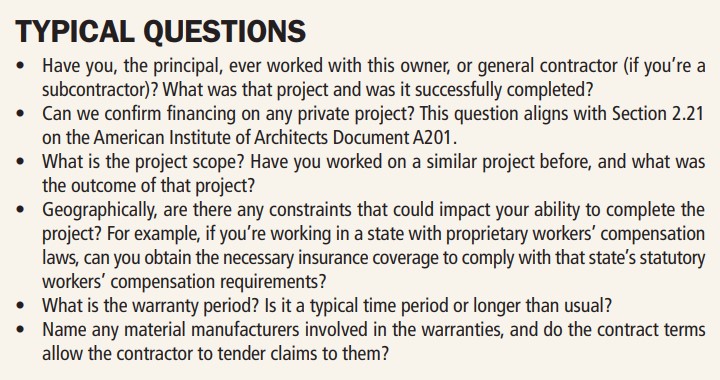January 2023 – Construction Prep – Preparing for Surety Bond Underwriter Queries

If you’ve been involved in a large construction project, you are familiar with surety bonds and all of the underwriter’s questions you need to answer. If you’re new to the game, it can be daunting.
Many small contractors pass on bidding for projects if they require a surety bond. But it doesn’t have to be that way as long as you are prepared and know what kind of questions the surety insurer’s underwriter will be asking.
Surety bonds protect project owners from loss if the contractor’s work is defective or of poor quality, or if the contractor fails to complete the work or follow the terms and conditions in the agreement.
For example, if the contractor fails to finish a project due to a shortage of workers or financial problems, the surety company has to step in and perform in the contractor’s place. Obviously, it’s in the carrier’s best interest to insure projects where they won’t be asked to perform. As a result, the questioning can feel like an inquisition, but it’s worth it to be prepared so that the insurer underwrites the bond and you can get to work.

Other areas of scrutiny
Besides the questions in the box, the insurer will also likely want to know:
- If the start and completion dates in the contract are feasible.
- The amount of the bid bond if there is one.
- Any warranty terms and if they are sensible.
- The payment terms and if they will allow the owner to manage expenses during the life of the project.
- If there is any retainage, or the withholding of the final contract payment for a specific time period to ensure that the job has been properly completed.
- If there are any damages that are set out in the contract in case of non-performance or shoddy workmanship.
- If the contractor’s costs to complete other projects it is working on are sufficient to ensure that it can cover its general and administrative costs in the following year.
The above list is not exhaustive and some surety insurers may have different areas of interest.
The bottom line is you’ll want to make sure your finances are up to snuff and that you have a strong track record.
January 2023 – Top 10 California Laws, Regs for 2023

A slew of new laws and regulations that will affect California businesses are taking effect for 2023.
Last year was a busy one, with ground-breaking new laws on employee pay disclosures, a law prohibiting discrimination against cannabis-using employees and another expanding the circumstances when employees can take leave to care for a loved one. The following are the top 10 laws and regulations that employers in the Golden State need to stay on top of.
1. Pay disclosure
This sweeping law in part requires more disclosure of pay information by employers. Under current law, employers are required to provide the pay scale for a position upon reasonable request by a job applicant. SB 1162 goes a step further by:
- Requiring employers, upon request by a current employee, to provide the pay scale of the position they are employed in.
- Requiring employers with 15 or more workers to include pay scale in any job postings for open positions.
- Requiring employers to maintain records of job titles and wage rate history for each employee while employed for the company, as well as three years after their employment ceases.
Note: The law defines “pay scale” as the salary or hourly wage range that the employer “reasonably expects” to pay for the position. Penalties range from $100 to $10,000 per violation. This law took effect Jan. 1, 2023.
2. State of emergency and staff
This new law, SB 1044, bars an employer, in the event of a state of emergency or emergency condition, from taking or threatening adverse action against workers who refuse to report to, or leave, a workplace because they feel unsafe. “Emergency condition” is defined as:
- Conditions of disaster or extreme peril to the safety of persons or property caused by natural forces or a criminal act.
- An order to evacuate a workplace, worksite or worker’s home, or the school of a worker’s child due to a natural disaster or a criminal act.
SB 1044 also bars employers from preventing employees from using their mobile phones to seek emergency assistance, assess the safety of the situation or communicate with another person to confirm their safety. The law, which took effect Jan. 1, 2023, does not cover first responders and health care workers.
3. Cannabis use and discrimination
This law bars employers from discriminating in hiring, termination or other conditions of employment based on employees using cannabis while off duty. The bill’s author says the legislation is necessary because THC (tetrahydrocannabinol), the active ingredient in marijuana, can stay in a person’s system after they are no longer impaired. As a result, drug testing may detect THC in an employee’s system even if they used it weeks earlier and it is having no effect on their job performance. AB 2188 does not require employers to permit employees to be high while working. The bill would exempt construction trade employees and would not preempt state or federal laws that require employees to submit to drug testing. This law takes effect Jan. 1, 2024.
4. Leaves of absence
The California Family Rights Act and the state’s paid sick leave law allow employees to take leave to care for a family member, defined as a spouse, registered domestic partner, child, parent, parent-in-law, grandparent, grandchild or sibling. The definition has been expanded to include “any individual related by blood or whose association with the employee is equivalent of a family relationship.”
5. Contractor workers’ comp
Starting July 1, the following contractors must carry workers’ compensation coverage regardless of if they have employees or not:
- Concrete (C-8 license)
- Heating and air conditioning (C-20)
- Asbestos abatement (C-22), and
- Tree service (D-49).
Starting Jan. 1, 2026, all licensed contractors must have coverage.
6. OSHA citation postings
Under current law, employers that receive citations and orders from OSHA are required to post them in or near the place the violation occurred, in order to warn employees about a potential hazard. Starting Jan. 1, 2023, they must post the notice not only in English, but also: Spanish, Chinese (Cantonese, Mandarin), Vietnamese, Tagalog, Korean, Armenian and Punjabi.
7. Permanent COVID standard
Cal/OSHA has a permanent COVID-19 prevention standard that will sunset in 2024. The new standard, which replaces the temporary emergency standard the agency had implemented, should provide more certainty for prevention procedures and practices. Here are the main takeaways:
- Employers are no longer required to pay employees while they are excluded from work due to COVID-19, or to screen employees daily.
- Employers must still notify and provide paid testing to employees who had a close contact in the workplace.
- Employers can now incorporate written COVID-19 procedures into their Injury and Illness Prevention Programs.
8. CalSavers expanded
SB 1126 requires any person or entity with at least one employee to either provide them with access to a retirement program like a 401(k) plan or enroll them in the state-run CalSavers program. Prior to this new law only companies with five or more employees that do not offer a retirement plan are required to enroll their workers in CalSavers.
9. Bereavement leave
Employers with five or more workers are required to provide up to five days of bereavement leave upon the death of a family member, under a new law starting in 2023. This leave may be unpaid, but the law allows workers to use existing paid leave available to them, such as accrued vacation days, paid time off or sick leave. Employers are authorized to require documentation to support the request for leave.
10. PFL wage replacement
This law was passed last year but does not take effect until 2025. Existing California law allows employees to apply for Paid Family Leave and State Disability Insurance, both of which provide partial wage replacement benefits when employees take time off work for various reasons under the California Family Rights Act. Starting in 2025, low-wage earners (those who earn up to 70% of the state average quarterly wage) will be eligible for a higher percentage of their regular wages under the state’s PFL and SDI benefit programs.
April 2022 – Risk Management – Don’t Let a Subcontractor Derail Your Safety Efforts

ONE OF the biggest challenges construction businesses face is preventing subcontractors’ and suppliers’ poor or non-existent safety practices from denting their own safety program.
While you may consider a number of factors when vetting a new subcontractor or vendor, one area that is often overlooked is their workplace safety practices.
This mistake can cost you dearly if one of their workers causes an incident at your worksite. In addition to an injury to one of your own employees, you could get a visit from an Occupational Safety and Health Administration inspector.
The National Safety Council’s Campbell Institute recently conducted a study of organizations with excellent safety records to identify the best practices for subcontractor and vendor safety.
As part of the study it identified five steps during a contractor or vendor relationship when it’s incumbent on a hiring company to evaluate the workplace safety habits of their business partners.
Prequalification
The institute recommends looking at more than just a company’s experience modifi cation rate. It says safety-minded fi rms assess subcontractors in multiple areas, such as their total recordable incident rate, fatality rate, days away from work for injured workers, restricted or transferred rate, and other OSHA recordables for the last three years.
Many firms also ask for environmental reports, written safety programs, permits, licenses, and continuous improvement programs.
Pre-job task and risk assessment
Before a subcontractor begins work, institute members recommend having a method for evaluating the risk of the work that is to be performed. Doing this can help you understand the scope of the work and give you a chance to put into place a new written safety program if the risk is deemed high.
Most importantly, subcontractors should be required to adhere to the same safety standards as your company.
Training and orientation
You should require safety orientation and skills training for subcontractors before they step onto your jobsite. Also, if they are doing highly specifi c work, you should ensure they have any required permits or special training. Some of the jobs that fit into that category are confi ned-space entry, electrical work, hot work, energy control, forklifts, and elevated work.
Job monitoring
Many safety-minded companies monitor work with daily checklists, pre-shift tailgate or safety meetings and weekly walkthrough inspections. Some of the companies surveyed for the study also require contract employees to submit a certain amount of safety observations and utilize mobile applications to report non-compliance or unsafe conditions. Also, you need to keep up-to-date incident logs, as this is crucial to monitoring subcontractor safety during a project.
Post-job evaluation
Conduct a post-job evaluation. During this phase look at safety, customer service and the quality of the fi nished work, and use those factors in determining the subcontractor’s eligibility for future contracts.





